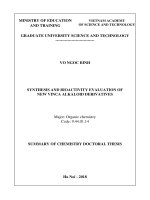Synthesis and antiproliferative evaluation of N alkylated (2(4methoxyphenyl)1Hbenzodimidazol5(6)yl)(phenyl)methanone derivatives.
Bạn đang xem bản rút gọn của tài liệu. Xem và tải ngay bản đầy đủ của tài liệu tại đây (12.44 MB, 134 trang )
VIETNAM GENERAL CONFEDERATION OF LABOUR
TON DUC THANG UNIVERSITY
FACULTY OF APPLIED SCIENCE
LE QUOC TUAN
SYNTHESIS AND
ANTIPROLIFERATIVE EVALUATION
OF N- ALKYLATED (2-(4METHOXYPHENYL)-1HBENZO[D]IMIDAZOL-5(6)YL)(PHENYL)METHANONE
DERIVATIVES
UNDERGRADUATE THESIS OF CHEMICAL ENGINEERING
ORGANIC SYNTHESIS
HO CHI MINH CITY, YEAR 2023
VIETNAM GENERAL CONFEDERATION OF LABOUR
TON DUC THANG UNIVERSITY
FACULTY OF APPLIED SCIENCE
LE QUOC TUAN- 61602260
SYNTHESIS AND
ANTIPROLIFERATIVE EVALUATION
OF N- ALKYLATED (2-(4METHOXYPHENYL)-1HBENZO[D]IMIDAZOL-5(6)YL)(PHENYL)METHANONE
DERIVATIVES
UNDERGRADUATE THESIS OF CHEMICAL ENGINEERING
ORGANIC SYNTHESIS
Advised by
Assoc. Prof., Dr. Hoang Thi Kim Dung
M.Eng., Phan Ngoc Kim Ngan
HO CHI MINH CITY, YEAR 2023
ACKNOWLEDGMENT
I sincerely thank all Faculty of Applied Sciences lecturers who provided me
with valuable information in their respective fields.
Headforemost, I want to express my thankful gratitude to Assoc. Prof., Dr.
Hoang Thi Kim Dung, for all of her guidance and support throughout the writing of
my thesis and her kindness, patience, and knowledge. In addition to writing and
conducting academic research in organic chemistry, I have received many helpful and
constructive recommendations about my field.
Additionally, I would like to thank Ms. Phan Ngoc Kim Ngan, who has
supported and managed my project and has been encouraging and instructive
throughout the research. Her extensive knowledge and academic guidance were
crucial in assisting me in completing my thesis. Besides, I'd like to thank everyone in
the Organic Chemistry and Polymer department for their continued friendliness and
assistance during the period with report documents and presentations.
Finally, I sincerely thank my family, especially my parents. Through every
accomplishment in my life, they have always been there for me with their
unconditional love and wholehearted support.
Ho Chi Minh City, day … month … 2023
Author
This thesis was carried out at Ton Duc Thang University.
Advisor:
Assoc. Prof., Dr. Hoang Thi Kim Dung
M.Eng., Phan Ngoc Kim Ngan
This thesis is defended at the Undergraduate Thesis Examination Committee was
hold at Ton Duc Thang University on…
Confirmation of the Chairman of the Undergraduate Thesis Examination Committee
and the Dean of the faculty after receiving the modified thesis (if any).
CHAIRMAN
...........................................
DEAN OF FACULTY
...................................................
DECLARATION OF AUTHORSHIP
I hereby declare that this thesis was carried out by myself under the guidance
and supervision of Assoc. Prof. Dr. Hoang Thi Kim Dung, and that the work and
the results contained in it are original and have not been submitted anywhere for any
previous purposes. The data and figures presented in this thesis are for analysis,
comments, and evaluations from various resources by my own work and have been
duly acknowledged in the reference part.
In addition, other comments, reviews, and data used by other authors and
organizations have been acknowledged, and explicitly cited.
I will take full responsibility for any fraud detected in my thesis. Ton Duc
Thang University is unrelated to any copyright infringement caused on my work (if
any)
Ho Chi Minh City, day month year
Author
i
ABSTRACT
In
this
thesis,
ten
(2-(4-methoxyphenyl)-1H-benzo[d]imidazol-5(6)-
yl)(phenyl)methanone derivative was successfully synthesis via condensation of the
o-phenylenediamine derivative with aromatic aldehyde derivative in the presence of
Na2S2O5 using the mixed solvent of EtOH: H2O (9:1, v/v). Subsequently, ten
derivatives of N-alkylated benzimidazole were designed and synthesized by
alkylation reactions in the presence of K2CO3 using dimethyl sulfoxide as a solvent.
All synthesized compounds were characterized by HPLC, UV-Vis, FT-IR, 1D and
2D-NMR, and HRMS. The antiproliferative test determined activity against a human
breast cancer cell line (MDA-MB-231) by the SRB method. The results revealed that
compounds 3, 6b, and 6d displayed antiproliferative activities against tested cancer
cell line with IC50 values ranging from 48,58- 70,93 M.
TÓM TẮT
Trong luận văn này, 10 dẫn xuất của (2-(4-methoxyphenyl)-1Hbenzo[d]imidazol-5(6)-yl)(phenyl)methanone đã được tổng hợp thành công bằng
phản ứng ngưng tụ giữa dẫn xuất của o-phenylenediamine và dẫn xuất andehyde
aldehyde thơm có sử dụng xúc tác Na2S2O5 trong hỗn hợp dung môi EtOH: H2O (9:1,
v/v). Sau đó, mười dẫn xuất alkyl hóa tại vị trí N-1 của benzimidazole được tổng hợp
bằng phản ứng alkyl hóa với xúc tác K2CO3 trong dung mơi DMSO. Các hợp chất đã
tổng hợp được xác định tính chất bằng HPLC, UV- Vis, FT- IR, 1D và 2D- NMR,
và HRMS. Khả năng ức chế tăng sinh tế bào được thử nghiệm trên dong dòng tế bào
ung thư vú MDA-MB-231 bằng phương pháp SRB. Kết quả thử nghiệm cho thấy hợp
chất 3, 6b và 6d thể hiện hoạt tính ức chế sự phát triển của dòng tế bào ung thư nghiên
cứu với giá trị IC50 từ 48.58– 70.93 µM.
ii
TABLE OF CONTENTS
ABSTRACT ............................................................................................................... i
TÓM TẮT .................................................................................................................. i
LIST OF FIGURES ..................................................................................................v
LIST OF SCHEMES............................................................................................... vi
LIST OF TABLES ................................................................................................. vii
LIST OF ABBREVIATIONS............................................................................... viii
INTRODUCTION .....................................................................................................1
CHAPTER 1. LITERATURE REVIEW ................................................................3
1.1. Benzimidazoles .................................................................................................3
1.1.1. Introduction ...............................................................................................3
1.1.2. Physicochemical properties .......................................................................3
1.1.3. Application ................................................................................................4
1.2. Overview to 2,5(6)-disubstituted benzimidazole derivatives ...........................6
1.2.1. Synthetic method .......................................................................................6
1.2.2. Biological activities ...................................................................................9
1.3. Overview to N- alkylated benzimidazole derivatives .....................................11
1.3.1. Synthesis of N- alkylated ........................................................................11
1.3.2. Antiproliferative activities ......................................................................12
CHAPTER 2. EXPERIMENTAL .........................................................................15
2.1. Materials and instrumentations .....................................................................15
2.1.1. Materials ..................................................................................................15
2.1.2. Instrumentations ......................................................................................16
iii
2.2. Procedure for synthesis of (2-(4-methoxyphenyl)-1H-benzo[d]imidazol-5(6)yl)(phenyl)methanone (3) ......................................................................................16
2.3. General procedure for the synthesis of N- alkylated (2-(4-methoxyphenyl)1H-benzo[d]imidazol-5(6)-yl)(phenyl)methanone derivatives .............................17
2.4. Isolation method and structure determination ...............................................18
2.4.1. Isolation method ......................................................................................18
2.4.2 Structure determination ............................................................................19
2.5. Antiproliferative test.......................................................................................21
CHAPTER 3: RESULT AND DISCUSSION .......................................................22
3.1. Chemistry .......................................................................................................22
3.1.1. (2-(4-methoxyphenyl)-1H-benzo[d]imidazol-5(6)-yl)(phenyl)methanone
...........................................................................................................................26
3.1.2 N- alkylated (2-(4-methoxyphenyl)-1H-benzo[d]imidazol-5yl)(phenyl)methanone derivatives .....................................................................27
3.2. Structure determination .................................................................................36
3.2.1. Compound (2-(4-methoxyphenyl)-1H-benzo[d]imidazol-5yl)(phenyl)methanone (Compound 3) ...............................................................36
3.2.2. Compound (2-(4-methoxyphenyl)-1-propyl-1H-benzo[d]imidazol-5yl)(phenyl)methanone (Compound 5a) .............................................................37
3.2.3. Compound (2-(4-methoxyphenyl)-1-propyl-1H-benzo[d]imidazol-6yl)(phenyl)methanone (Compound 6a) .............................................................38
3.2.4. Compound (1-butyl-2-(4-methoxyphenyl)-1H-benzo[d]imidazol-5yl)(phenyl)methanone (Compound 5b) ............................................................39
3.2.5. Compound (1-butyl-2-(4-methoxyphenyl)-1H-benzo[d]imidazol-6yl)(phenyl)methanone (Compound 6b) ............................................................40
3.2.6. Compound (2-(4-methoxyphenyl)-1-pentyl-1H-benzo[d]imidazol-5yl)(phenyl)methanone (Compound 5c) .............................................................41
iv
3.2.7. Compound (2-(4-methoxyphenyl)-1-pentyl-1H-benzo[d]imidazol-6yl)(phenyl)methanone (Compound 6c) .............................................................42
3.2.8. Compound (1-hexyl-2-(4-methoxyphenyl)-1H-benzo[d]imidazol-5yl)(phenyl)methanone (compound 5d) .............................................................43
3.2.9. Compound (1-hexyl-2-(4-methoxyphenyl)-1H-benzo[d]imidazol-6yl)(phenyl)methanone (compound 6d) .............................................................44
3.2.10. Compound (1-heptyl-2-(4-methoxyphenyl)-1H-benzo[d]imidazol-5yl)(phenyl)methanone (compound 5e) ..............................................................45
3.2.11. Compound (1-heptyl-2-(4-methoxyphenyl)-1H-benzo[d]imidazol-6yl)(phenyl)methanone (compound 6e) ..............................................................46
3.3. Discussion ......................................................................................................46
3.3. Antiproliferative result ...................................................................................53
CHAPTER 4. CONCLUSION ...............................................................................56
4.1. Concluding remark.........................................................................................56
4.2. Suggestion on future work ..............................................................................56
REFERENCES ........................................................................................................57
v
LIST OF FIGURES
Figure 2.1 Illustration of procedure for synthesizing compound 3 ..........................16
Figure 2.2 Illustration of procedure for synthesizing 5a-e and 6a-e ........................17
Figure 3.1 Sample and TLC of 3 ............................................................................. 26
Figure 3.2 Sample and TLC of 5a ........................................................................... 27
Figure 3.3 Sample and TLC of 5b .......................................................................... 28
Figure 3.4 Sample and TLC of 6b .......................................................................... 29
Figure 3.5 Sample and TLC of 5c ........................................................................... 30
Figure 3.8 Sample and TLC of 6c ........................................................................... 31
Figure 3.7 Sample and TLC of 5d .......................................................................... 32
Figure 3.8 Sample and TLC of 6d .......................................................................... 33
Figure 3.9 Sample and TLC of 5e ........................................................................... 34
Figure 3.10 Sample and TLC of 6e ......................................................................... 35
Figure 3.11 UV-Vis absorption spectra of compounds 3, 5a−e, 6a−e.................... 46
Figure 3.12 1H-NMR spectra of compound 6b (A) and compound 5b (B)
Figure 3.13 2D-NMR spectra of 6b. a) NOESY spectrum, correlations between H-7
and H-1” are circled in red color. b) HMBC spectrum, correlations between H-1” and
C-2 and C-8 are circled in blue color. ......................................................................
Figure 3.14 2D-NMR spectra of 5b. a) NOESY spectrum, correlations between H-7
and H-1” are circled in red color. b) HMBC spectrum, correlations between H-1” and
C-2 and C-8 are circled in blue color. ......................................................................
vi
LIST OF SCHEMES
Scheme 1.1 Benzimidazole structure and numbering rule .........................................3
Scheme 1.2 Phillips's reaction of o-phenylenediamine and oxalic acid .....................6
Scheme 1.3 Reaction of o-phenylenediamine with anhydride acetic .........................7
Scheme 1.4 Reaction of 3,4- diamino-toluene with ethyl formate .............................7
Scheme 1.5 Reaction of aryldiamine with 4-hydroxy-5,8-dimethoxy-2naphthaldehyde ...................................................................................................8
Scheme 1.6 Reaction of o-phenylenediamnie with aldehyde .....................................8
Scheme 1.7 Benzimidazole synthesis by oxidation of air ..........................................8
Scheme 1.8 Benzimidazole synthesis with microwave- assisting ..............................8
Scheme 1.9 General structures of compounds 1-6 .....................................................9
Scheme 1.10 Compounds 4a and 4b in the study of Nayak et al.. ...........................10
Scheme 1.11 Structures of compounds 38 and 40 ....................................................10
Scheme 1.12 Alkylation reaction of Nale et al. ........................................................12
Scheme 1.13 Alkylation reaction of Chakraborty et al. ...........................................12
Scheme 1.14 Structure of compound 4k ..................................................................12
Scheme 1.15 Structure of compound TJ08 ..............................................................13
Scheme 1.16 Structure of compound 4c ...................................................................14
Scheme 2.1 Procedure for synthesis of 3 .................................................................16
Scheme 2.2 General procedure for the synthesis of 5a-e, 6a-e ................................17
Scheme 3.1 General procedure for the synthesis of the final compounds 5a−e, 6a−e
...........................................................................................................................24
Scheme 3.2. Mechanism of the alkylation reaction ..................................................25
vii
LIST OF TABLES
Table 1.1 Marketed medicines containing benzimidazole moiety .............................5
Table 1.2 IC50 values of compounds 38 and 40 against MDA-MB-231 ..................10
Table 1.3 IC50 values of compound TJ08 against six cancer cells and normal cells
...........................................................................................................................13
Table 2.4 List of chemicals ......................................................................................15
Table 2.5 List of instrumentations ............................................................................16
Table 2.6 HPLC condition ........................................................................................18
Table 2.7 NMR techniques for structure determination were used in this thesis.....20
Table 3.1 Yield of synthesized ................................................................................. 23
Table 3.2 Comparison between the 1H-NMR chemical shift of this study with
previous reports. ....................................................................................................... 35
Table 3.3 IC50 of synthesized compounds (3, 5a-e, 6b-e) ....................................... 52
viii
LIST OF ABBREVIATIONS
EA
ethyl acetate
Chemical shift
d
doublet
dd
doublet of doublets
DI Water
Deion water
DMSO
dimethyl sulfoxide
dt
doublet of triplets
EtOH
ethanol
FT- IR
Fourier transform Infrared spectroscopy
Hex
n- hexane
HMBC
Heteronuclear Multiple Bond Coherence
HPLC
High- performance Liquid Chromatography
HRMS
High-Resolution Mass Spectroscopy
HSQC
Heteronuclear Single Quantum Coherence
J
Coupling constant
m
multiplet
MeCN
acetonitrile
MeOH
methanol
NMR
Nuclear Magnetic Resonance Spectroscopy
Rf
retardation factor
s
singlet
t
triplet
TCA
trichloracetic acid
TLC
Thin Layer Chromatography
tt
triplet of triplets
1
INTRODUCTION
1. Introduction
Cancer is one of the fatal causes of death worldwide, necessitating the
development of novel and effective treatments. Even though modern therapeutic
agents have been developed over the last 100 years, the successful treatment of cancer
appears to be a formidable challenge at the start of the century. According to
GLOBOCAN's 2020 forecast, approximately 19.3 million cancer diagnoses and 10
million cancer deaths are predicted worldwide in 2020. Breast cancer (BC) is 1 in 4
commonly diagnosed cancers and the second most significant cause of cancer-related
deaths in women; about 12% of breast cancers are triple negative. This obstacle
results from the challenges of discovering innovative selective medicines that
suppress tumor cell development without being harmful to normal cells.
Historically, nitrogen-containing heterocycles are an exciting research topic
because they are bioactive compounds. Due to their reputation, N-heterocycles are
essential for studying biological activities. Among them, benzimidazoles greatly
interest many research groups investigating drug development. Mounting evidence
indicates that benzimidazole and its derivatives, with substitutions at the 1, 2, 5,
and/or 6-positions, have a vast medicinal profile in multiple categories of therapeutic
agents with unique properties, including antimicrobial,anti-hypertensive, antituberculosis, anti-viral, antiulcer, anti-inflammatory, anti-diabetic, anti-convulsant
and anti-malarial. In addition, many studies already reveal the potential of
benzimidazole derivatives as anticancer medicines. In our previous work,
benzimidazole derivatives have been synthesized, and in terms of anticancer
activities, (2-(4-methoxyphenyl)-1H-benzo[d]imidazol-5(6)-yl)(phenyl)methanone
emerged as multitarget anticancer agent, especially in anticancer effect against breast
cancer cell line (MDA-MB-231). Encouraged by these findings, in this study, we
considered introducing the alkyl straight chains to the benzimidazole moiety to
produce new molecules with the expectation of increasing anticancer activity.
2
2. Aims and objectives
With the above preamble, the present work entitled "Synthesis and
antiproliferative
evaluation
of
N-
alkylated
(2-(4-methoxyphenyl)-1H-
benzo[d]imidazol-5(6)-yl)(phenyl)methanone derivatives" has been done with the
following objectives:
i.
Dealing with developing a method for synthesizing benzimidazole and
N-alkylated benzimidazole derivatives and characterizing them by
physical and spectral analysis.
ii.
Dealing with evaluating synthesized derivatives for antiproliferative
activity against breast cancer cell line (MDA-MB-231).
The objective of the current work has been aimed at achieving the following,
i.
To synthesize a nucleus containing benzimidazole.
ii.
To synthesize targeted N-alkylated benzimidazole isomers.
iii.
To isolate the N-alkylated benzimidazole derivative in a mixture of
positional isomers.
iv.
To establish the structure based on melting point, UV-Vis, FT-IR,
NMR, and HRMS spectra.
v.
To evaluate compounds for antiproliferative activity.
3
CHAPTER 1. LITERATURE REVIEW
1.1. Benzimidazoles
1.1.1. Introduction
Benzimidazole is a compound consisting of a phenyl ring attached to an
imidazole ring that was first synthesized by Hoebrecker by reduction of 2-nitro-4methylacetanilide to obtain 2,5(or 2,6)- dimethylbenzimidazole in 1872 [1].
In the following years, Ladenburg and Philip found synthetic pathway of
benzimidazole by condensing o-phenylenediamine with carbonyl group compounds.
Therefore, the preparation of benzimidazole from ortho-amino aniline is referred to
as the Ladenburg method, Phillips’s method [2], [3].
In 1949, Brink et al. proved the appearance of a benzimidazole scaffold as the
ligand during the degradation of vitamin B12. Consequently, the connection between
benzimidazole structure and biological activities was identified [4].
Benzimidazole structure and numbering rules are described in Scheme 1.1
Scheme 1.1 Benzimidazole structure and numbering rule
Due to tautomerization, 1H-benzimidazole derivatives exist as isomers. The two
derivatives, 5-methylbenzimidazole, and 6-methylbenzimidazole, illustrate a pair of
tautomers and describe the same substance. However, no tautomerization occurs
when a substituent at the N-1 position is larger than the hydrogen, but a characteristic
isomer forms [1].
1.1.2. Physicochemical properties
The benzimidazoles are simply solids with relatively high melting points (1Hbenzimidazole, 170°C). Generally, when a substituent is added to the N-1 position,
the melting point of benzimidazoles decreases (1-methyl-1H-benzimidazole, 66oC)
[5] because benzimidazoles cannot form intermolecular hydrogen bonds because the
hydrogen is at N- 1 was replaced.
4
The 1H-benzimidazoles are highly soluble in polar solvents and sparingly soluble
in nonpolar solvents. When substituents of different polarities are attached to the
benzimidazole ring, they are soluble in the respective solvent. For example, 2methylbenzimidazole is well-soluble in the ether, while 2-aminobenzimidazole is
highly soluble in water [14].
1.1.3. Application
Benzimidazole derivatives have been applied in a variety of industries: textile
dying [6], semi-conduction [7], and anti-corrosion [8],...However, benzimidazole
derivatives gain more attention in pharmaceuticals due to their biological activities.
Several commercial drugs containing benzimidazole moiety are used in clinical
applications, such as antibacterial [9], antifungal [9], antiallergic activities [10],
analgesics [11], blocking of the proton pump (H+/K+-ATPase) [12]… Instances are
described in Table 1.1.
5
Table 1.1 Marketed medicines containing benzimidazole moiety
No.
Uses of drugs
Example
1
Treatment of
geohelminth
infections [13]
2
Antihistamine [14]
3
Blocking of the proton
pump [15]
Omeprazole
4
Analgesic [16]
Clonitazene
5
Hypotension [17]
Mebendazole
Clemizole
Azilsartan
Nocodazole
[18]
Veliparib [19]
6
Anticancer
Bendamustine
[20]
Structure
6
1.2. Overview to 2,5(6)-disubstituted benzimidazole derivatives
1.2.1. Synthetic method
The most common way to synthesize benzimidazole is condensation between
benzene derivatives containing substitution groups of nitrogen at 1,2 position and
carbonyl group-containing compound.
1.2.1.1. Reaction with carboxylic acid
In 1928, Phillips et al. successfully synthesized benzimidazole derivatives for
the first time by condensation o-phenilenediamine with oxalic acid, malonic acid, and
benzoic acid by boiling mixtures with HCl [3].
Scheme 1.2 Phillips's reaction of o-phenylenediamine and oxalic acid
Based on Phillips’s research, further studies were practiced to synthesize more
complex benzimidazole derivatives. In 1983, J. Gerald Wilson and Frederick C. Hunt
successfully synthesized iminodiacetic acid derivatives of benzimidazole [21], [22].
Although the Phillips reaction is commonly used to synthesize benzimidazole
derivatives, it has limitations when reagents are aromatic carboxylic acid, especially
when complex substitute groups or heteroatoms are included [23].
1.2.1.2.Reaction with anhydride
The reaction products between o-phenylenediamine and acid anhydride are
benzimidazole or N, N'-diacylphenylenediamine, depending on the operating
conditions and reaction duration. A high yield of benzimidazole is achieved when the
reaction time is sufficiently prolonged. Under refluxed boiling conditions, the ophenylenediamine cyclization process with acetic anhydride is entirely converted to
2-methylbenzimidazole. This may be accomplished with acetic anhydride alone,
sodium acetate, or acetic acid [1].
7
Scheme 1.3 Reaction of o-phenylenediamine with anhydride acetic
In addition, o-phenylenediamine combines with succinic anhydride and
phthalic anhydride to form, respectively, -(2-benzimidazole) propionic acid and o(2-benzimidazole) benzoic acid [1].
1.2.1.3 Reaction with ester
First discovered by Von Niementowski, the synthesis of benzimidazole from
o-phenylenediamine and an ester. Nevertheless, this approach is not commonly used.
In a sealed vessel, 3,4-diamino-toluene dihydrochloride and ethyl formate were
heated continuously at 225oC for three hours to produce 5(6)-methylbenzimidazole
hydrochloride. This product is not further alkylated by the ethyl chloride that is made
[1].
Scheme 1.4 Reaction of 3,4- diamino-toluene with ethyl formate
1.2.1.4. Reaction with aldehyde
Under the varied case, the condensation reaction between o-phenylenediamine
and aldehyde yields benzimidazole with a substituent at the second position. The best
circumstances are typically reaction conditions in the presence of air or oxidizing
substances [1].
Binh Phung et al. synthesized benzimidazole derivatives from oarylenediamine and 4-hydroxy-5,8-dimethoxy-2-naphthaldehyde in DMSO at 100 °C
using Na2S2O5 [24].
8
Scheme 1.5 Reaction of aryldiamine with 4-hydroxy-5,8-dimethoxy-2naphthaldehyde
Xiangming
et
al.
synthesized
benzimidazole
derivatives
from
o-
phenylenediamine and various aldehydes using NaHSO3 in DMF at 80oC [25]
Scheme 1.6 Reaction of o-phenylenediamnie with aldehyde
Lin et al. used air as the oxidant reagent and dioxane as a solvent for high yield
(90%) in synthesizing benzimidazole derivatives [26].
Scheme 1.7 Benzimidazole synthesis by oxidation of air
Besides using classical methodologies (heating), several studies applied modern
methods to synthesize benzimidazole, specially synthesized with microwave support.
Navarrete‐Vázquez et al., by microwave-assisting,
successfully synthesized
benzimidazole deliveries [27].
Scheme 1.8 Benzimidazole synthesis with microwave- assisting
Hue et al. used microwave irradiation to assist in synthesizing several
complicated benzimidazole derivatives [28].
9
1.2.2. Biological activities
Recently, derivatives of 2,5(6)-disubstituted benzimidazole gained the
attention of many chemists due to their biological activities and application in the
clinic.
Aurelio Romero-Castro and co-workers (2011) [29] reported a series of six 2aryl-5(6)-nitro-1H-benzimidazole derivatives (1−6) as promising anticancer
candidates. Antiproliferative activities using the MTT assay were screened against
seven human neoplastic cell lines (K562, HL60, MCF-7, MDA231, A549, HT29 và
KB.).
Scheme 1.9 General structures of compounds 1-6
The results indicated that compound 6 (R3=Cl, R4=NO2) was the most active
agent against all tested cancer cell lines, especially in MDA-MB-231 with an IC50
value of 4.0 M, and exhibited similar activity to a positive control (carboplatin).
Interestingly, this compound showed less antiproliferative effect against a nonneoplastic cell line (HACAT).
Nayak et al. [30] developed and synthesized the derivatives of the 2,6disubstituted
benzimidazole-oxindole
conjugate
and
assessed
them
as
chemotherapeutic agents against the human breast cancer cell line MCF-7. Among
synthesized analogs, compounds 4a and 4b displayed 43.7% and 43.6% at 1μM and
64.8% and 62.7% at 2μM apoptosis, respectively.
10
Scheme 1.10 Compounds 4a and 4b in the study of Nayak et al..
In 2020, our previous studies [31] were developed and successfully
synthesized twenty-nine of 2,5(6)-disubstituted benzimidazole derivatives under
facile and mild conditions. All compounds were tested for anticancer activity against
three cancer cell lines (A549, MDA-MB-231, and PC3).
Scheme 1.11 Structures of compounds 38 and 40
Regarding anticancer activities against MDA-MB-231 (a breast cancer cell
line), compounds 38 and 40 were the most promising agents for this cancer cell line
(as shown in Table 1.2 and Scheme 1.11).
Table 1.2 IC50 values of compounds 38 and 40 against MDA-MB-231
No.
Compound
IC50 (g/mL)
1
38
4,68 ± 0,42
2
40
3,55 ± 0,35
Continuing our work toward discovering and developing biologically active
agents, we envisaged the synthesis of new benzimidazole derivatives with a structure
based on compound 40 for evaluating the effect of new substitution on anticancer
activity against breast cancer.
11
1.3. Overview to N- alkylated benzimidazole derivatives
1.3.1. Synthesis of N- alkylated
1.3.1.1. Classification of the alkylation reaction
Alkylation substitutes alkyl groups for one or more hydrogen atoms in an
organic molecule. The alkyl group can directly bond to carbon, oxygen, nitrogen, or
sulfur, corresponding to C-alkylation, O-alkylation, N-alkylation, and S-alkylation,
respectively.
Alkylating agents such as alcohols (R-OH), alkyl halides (RX), alkyl sulfates,
sulfonic acid, and esters with catalyst agents such as HF, H2SO4, H3PO4, and Lewis
acids are often used in the alkylating reaction. Under diverse settings, alkylation
reactions will occur via distinct pathways [32].
1.3.1.2. Alkylation by Mannich reaction
Mannich reaction includes formaldehyde and a primary or secondary amine
alkylating a compound with the acidic proton next to a carbonyl group [33]. By
Mannich reaction, Roman. G et al. synthesized benzimidazole derivatives in 2012
[34].
1.3.1.3. Alkylation by activated alkene
Activated alkenes were used to alkylate benzimidazoles with high yield.
Although high-yield alkylation for benzimidazole, activated alkene requires the
compilated catalyst [35], [36].
1.3.1.4. Alkylation by alkyl halide and related compounds
Alkylation of benzimidazole derivatives by alkyl halide and the related
compounds has been commonly used for several previous studies.
Nale et al. synthesized benzimidazole derivatives from different ophenylenediamine derivatives and formamide, using zinc acetate catalysis in the
presence of poly (methylhydrosiloxane) to generate benzimidazole derivatives at the
N-1 position [37].
12
Scheme 1.12 Alkylation reaction of Nale et al.
Chakraborty et al. practiced the alkylation of benzimidazole by R-Br agent with
the presence of NaOH and SDS catalyzed for 75-98% yield [38].
Scheme 1.13 Alkylation reaction of Chakraborty et al.
Rohand et al. synthesized alkylated benzimidazole derivatives with alkyl halide
under the Transfer Catalysis condition [39]
1.3.2. Antiproliferative activities
Pham et al. (2022) [40] designed and synthesized forty-two N-substituted 6(chloro/ nitro)-1H-benzimidazole derivatives and evaluated them for their anticancer
activities.
Scheme 1.14 Structure of compound 4k
Compound 4k exhibited potent anticancer activity with IC50 < 10 M against
five tested cell lines (HepG2, MDA-MB-231, MCF7, C26, and RMS), which is
compared with the reference drug (PTX). The study concluded that the appearance
of the N-benzyl/N-(4-chlorobenzyl) group and the chloro/N,N-dimethylamino
moiety in the phenyl ring at position 2 of the 1H-benzimidazole scaffold is more
favorable for enhanced antitumor activity.

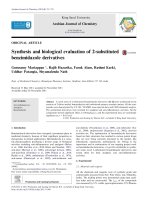
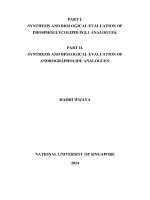
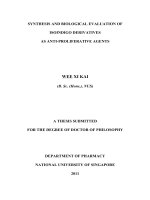

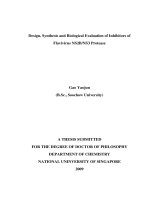

![DSpace at VNU: Synthesis and cytotoxic evaluation of novel dihydrobenzo[h] cinnoline-5,6-diones](https://media.store123doc.com/images/document/2017_12/16/medium_crk1513369880.jpg)

